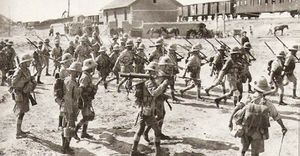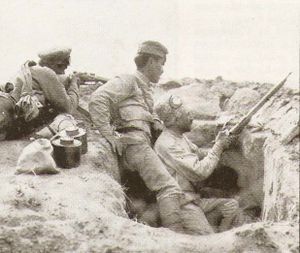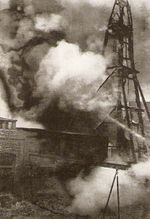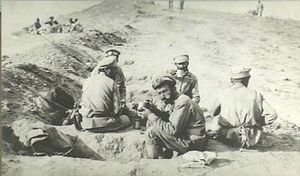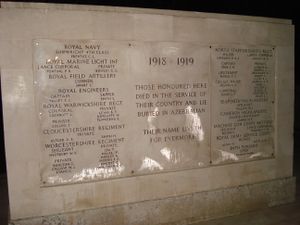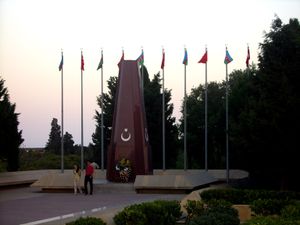معركة باكو
| Battle of Baku | |||||||
|---|---|---|---|---|---|---|---|
| جزء من the Armenian–Azerbaijani War & Caucasus Campaign | |||||||
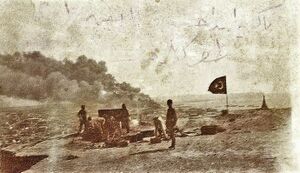 Ottoman artillery bombarding the city. | |||||||
| |||||||
| المتحاربون | |||||||
|
|
| ||||||
| القادة والزعماء | |||||||
|
|
| ||||||
| القوى | |||||||
|
14,000 infantry 500 cavalry 40 guns[1] |
6,000[1]to 9,151 infantry.[4] 40 guns[1] 1,000 infantry 1 artillery battery 1 machine gun section 3 armored cars 2 Martinsyde G.100 planes[1] 600[1] | ||||||
| الضحايا والخسائر | |||||||
| Total: 2,000[1] |
200[1] | ||||||
The Battle of Baku (آذربيجاني: Bakı döyüşü, روسية: Битва за Баку, تركية: Bakü Muharebesi) was a battle in World War I that took place on August–September 1918 between the Ottoman–Azerbaijani coalition forces led by Nuri Pasha and Bolshevik–Dashnak Baku Soviet forces, later succeeded by the British–Armenian–White Russian forces led by Lionel Dunsterville and saw briefly Soviet Russia renter the war. The battle was fought as a conclusive part of the Caucasus Campaign, but as a beginning of the Armenian–Azerbaijani War.[5][6]
خلفية
In 1917, the Russian Caucasus Front collapsed following the abdication of the Tsar. On 9 March 1917, the Special Transcaucasian Committee was established to fill the administrative gap in areas occupied in the course of the war on the Caucasian front by the Russian Provisional Government in the Transcaucasia. This administration, which included representatives of Armenian, Azerbaijani and Georgian groups, did not last long. In November 1917, the first government of the independent Transcaucasia was created in Tbilisi and named the Transcaucasian Commissariat following the Bolshevik seizure of power in St. Petersburg. On 5 December 1917, this new "Transcaucasian Committee" gave endorsement to the Armistice of Erzincan which was signed by the Russians with the command of the Ottoman Third Army.[7] Russian soldiers mainly left the front and returned to their homes. A number of Russian troops left for the Persian Campaign, contrary to the rules of the Armistice.[1] General Nikolai Baratov remained in Hamadan and at Kermanshah, a Russian colonel named Lazar Bicherakhov remained with 10,000 troops. Both forces were supplemented by British liaison officers.[1]
إرهاصات المعركة
- Opposing forces
Dunsterville (far left) with Dunsterforce staff.
Murad of Sebastia led his volunteers and died at the Battle of Baku[8]
المعركة
Outside city of Baku
On 6 June 1918, Grigory Korganov, People's Commissar of Military and Naval Affairs of the Baku Soviet, issued an order to the Red Army to begin offensive operations against Ganja.[9] Being unable to defend the independence of the country on their own, the government of Azerbaijan asked the Ottoman Empire for military support in accordance with clause 4 of the treaty between the two countries. The Baku Soviet troops looted and killed Muslims as they moved towards Ganja.[9] However many of the troops Shahumian requested from Moscow for the protection of Baku did not arrive because they were held up on the orders of Joseph Stalin in Tsaritsyn. Also, on Stalin's orders, grain collected in Northern Caucasus to feed the starving people in Baku was directed to Tsaritsyn. Shahumian protested to Lenin and to the Military Committee about Stalin's behavior and he often stated: "Stalin will not help us". Lack of troops and food would be decisive in the fate of the Baku Soviet.[10]
On 27 June - 1 July 1918, in the battle near Goychay, the Ottoman Islamic Army of the Caucasus defeated the Red Army and started advancing towards Baku. At this point, earlier in June, Bicherakhov was in the vicinity of Qazvin, trying to go north.[1] After defeating some Jangalis, he proceeded to check the situation in Baku.[1] Returning on 22 June, he planned to save the situation by blocking the Army of the Caucasus at Alyaty Pristan'.[1] However, he arrived too late, and instead went farther north to Derbent, planning to attack the invading Army of the Caucasus from the north. At Baku, he left only a small Cossack contingent.[1] Beside the Russians, the Jangalis also harassed elements of the Dunsterforce going to Anzali on their way to Baku. Once defeated, the Jangalis dispersed. On reaching Anzali in late July, Dunsterville also arrested the local Bolsheviks who had sided with the Jangalis.[1]
مدينة باكو
While Baku and its environs had been the site of clashes since June and into mid-August, the term Battle of Baku refers to the operations of 26 August - 14 September.[1][11] On 26 August, the Ottoman Islamic Army of the Caucasus launched its main attack against positions at the Wolf's Gate.[1] Despite a shortage of artillery, British and Baku troops held the positions against the Army of the Caucasus. Following the main assault, the Ottoman forces also attacked Binagadi Hill farther north, but also failed. After these attacks, reinforcements were sent to the Balajari station, from where they held the heights to the north.[1] However, faced with increased artillery fire from Ottoman forces, they retired to the railway line.[1]
Over the period 28–29 August, the Ottoman forces shelled the city heavily, and attacked the Binagadi Hill position. 500 Ottoman soldiers in close order charged up the hill, but were repulsed with the help of artillery. However, the under-strength British troops were forced to retire to positions further south.[1]
29 August– 1 September, the Ottoman forces managed to capture the positions of Binagadi Hill and Diga. Several coalition units were overrun, and losses were heavy. By this point, allied troops were pushed back to the saucer-like position that made up the heights surrounding Baku.[1] However, Ottoman losses were so heavy that Mürsel Bey was not immediately able to continue his offensive. This gave the Baku Army invaluable time to reorganize.[1] Faced with an ever-worsening situation, Dunsterville organized a meeting with the Centrocaspian Dictators on 1 September. He said that he was not willing to risk more British lives and hinted at his withdrawal. However, the dictators protested that they would fight to the bitter end, and the British should leave only when troops of the Baku Army did.[1] Dunsterville decided to stay until the situation became hopeless. Meanwhile, Bicherakhov captured Petrovsk, allowing him to send help to Baku. The reinforcements consisting of 600 men from his force, including Cossacks, raised hope.[1]
1–13 September, the Ottoman forces did not attack. During this period, the Baku force prepared itself and sent out airplane patrols constantly.[1] In his diary, Dunsterville reported the atrocities against the Muslim population perpetrated by Armenian militants.[12] On 12 September, an Arab officer from the Ottoman 10th Division deserted, giving information suggesting the main assault would take place on 14 September.[1]
On the night of 13/14 September, the Ottoman forces began their attacks. The Ottoman forces nearly overran the strategic Wolf's Gate (آذربيجاني: Qurd qapısı) west of Baku, from which the whole battlefield could be seen. However, their advance was halted by a counterattack. The fighting continued for the rest of the day, and the situation eventually became hopeless. By the night of 14 September, the remnants of the Baku Army and Dunsterforce evacuated the city for Anzali.[1]
On 30 October, The Armistice of Mudros was signed by the Ottoman Empire. Ottoman forces left the city.
الفظائع
أيام مارس
On 9 March 1918, the arrest of General Talyshinski, the commander of the Azerbaijani division, and some of its officers all of whom arrived in Baku increased the anti-Soviet feelings among the city's Azeri population. On 30 March, based on the unfounded report that the Azerbaijani (Muslim) crew of the ship Evelina was armed and ready to revolt against the Soviet, the Soviet disarmed the crew who tried to resist [9][13] The three days of inter-ethnic warfare referred to as the March Days, which resulted in the massacre of up to 12,000 Azerbaijanis by the Bolsheviks and armed Armenian units in the city of Baku and other locations in the Baku Governorate. The March events, beyond the violent three-day period, touched off a series of massacres all over Azerbaijan.[14]
أيام سبتمبر
In September 1918, a terrible panic in Baku ensued when the Ottoman Islamic Army of the Caucasus began to enter the city. Armenians crowded the harbour in a frantic effort to escape.[15] Regular Ottoman troops were not allowed to enter the city for two days, so that the locally recruited soldiers could massacre non-Muslims. This was permitted as revenge for a massacre of Azeris in March 1918.[16][17] It was the last major massacre of World War I.[18]
Aftermath
The British losses in the battle totaled about 200 men and officers killed, missing or wounded. Mürsel Bey admitted Ottoman losses of around 2,000.[1] Among the civilians the casualties of Baku's 80,000 person Armenian community were between 9,000 and 10,000, roughly equal to the number of Azeris massacred by Armenians and Bolsheviks during the March Days.[19] Altogether up to 20,000 Armenians were killed or deported.[20]
The capital of the Azerbaijan was finally moved from Ganja to Baku. However, after the Armistice of Mudros between the United Kingdom and the Ottoman Empire on October 30, Turkish troops were substituted by the Triple Entente. Headed by General William Thomson, British troops of 5,000 soldiers, including parts of Dunsterforce, arrived in Baku on 17 November, and martial law was implemented on the capital of Azerbaijan Democratic Republic until "the civil power would be strong enough to release the forces from the responsibility to maintain the public order".
No oil from Baku's oilfields got beyond Tbilisi before the Ottomans and Germans signed the armistice.[1] By 16 November, Nuri and Mürsel Bey were ejected from Baku and a British general sailed into the city, headed by one of the ships that had evacuated on the night of 14 September.[1]
A memorial in Baku was established to the Ottoman soldiers, who were killed in combat. There is also a memorial to the British soldiers in Baku.
انظر أيضاً
الهامش
- ^ أ ب ت ث ج ح خ د ذ ر ز س ش ص ض ط ظ ع غ ف ق ك ل م ن هـ و ي أأ أب أت أث خطأ استشهاد: وسم
<ref>غير صحيح؛ لا نص تم توفيره للمراجع المسماةcaven - ^ The Diaries of General Lionel Dunsterville: 1911-1922
- ^ Anastas Mikoyan. Так было. Moscow: Vagrius, 1999; Ch. 2.
- ^ Lisa Smedman. Dunsterforce. Vancouver Courier newspaper.[dead link]
- ^ Yale, William (1968) Near East: A Modern History p. 247
- ^ Dadyan, Khatchatur(2006) Armenians and Baku, p. 118
- ^ Tadeusz Swietochowski, Russian Azerbaijan 1905–1920, page 119
- ^ (Pasdermadjian 1918, pp. 22)
- ^ أ ب ت Firuz Kazemzadeh. Struggle For Transcaucasia (1917—1921), New York Philosophical Library, 1951
- ^ Kun, Miklós (2003). Stalin: An Unknown Portrait. Central European University Press.
- ^ Comtois, Pierre. "World War I: Battle for Baku". HistoryNet. Archived from the original on 30 September 2007. Retrieved 19 July 2007.
{{cite web}}: Unknown parameter|deadurl=ignored (|url-status=suggested) (help) - ^ Dunsterville, Lionel. "The Diaries of General Lionel Dunsterville, 1918". Great War Documentary Archive. Retrieved 10 January 2009.
- ^ Документы об истории гражданской войны в С.С.С.Р., Vol. 1, pp. 282–283.
- ^ F. Kazemzadeh. open citation, p. 73.
- ^ Christopher, Armenia, page = 260
- ^ Marshall, Alex (2009). The Caucasus Under Soviet Rule. Taylor & Francis. p. 96. ISBN 978-0-415-41012-0.
- ^ Milne, G. F. (4 January 1921). "War Office, 7th January, 1921". The London Gazette, Fourth Supplement. Retrieved 2 November 2012.
- ^ Andreopoulos, George(1997) Genocide: Conceptual and Historical Dimensions University of Pennsylvania Press, ISBN 0-8122-1616-4 p. 236
- ^ خطأ استشهاد: وسم
<ref>غير صحيح؛ لا نص تم توفيره للمراجع المسماةrusaz - ^ Coppieters, Bruno (1998). Commonwealth and Independence in Post-Soviet Eurasia. Routlege. p. 82. ISBN 0-7146-4480-3.
وصلات خارجية
- Dunsterville, Lionel. "The Diaries of General Lionel Dunsterville, 1918". Great War Documentary Archive. Archived from the original on 20 August 2007. Retrieved 24 July 2007.
{{cite web}}: Unknown parameter|deadurl=ignored (|url-status=suggested) (help)
- Pages using gadget WikiMiniAtlas
- Articles with dead external links from July 2017
- Harv and Sfn no-target errors
- CS1 errors: unsupported parameter
- Articles containing روسية-language text
- CS1: Julian–Gregorian uncertainty
- Coordinates on Wikidata
- Articles containing آذربيجاني-language text
- Pages using Lang-xx templates
- Articles with hatnote templates targeting a nonexistent page
- نزاعات 1918
- 1918 في أذربيجان
- تاريخ أرمنيا
- معارك حملة القوقاز
- معارك الحرب العالمية الأولى التي شاركت فيها الدولة العثمانية
- معارك الحرب العالمية الأولى التي شاركت فيها روسيا
- معارك الحرب العالمية الأولى التي شاركت فيها أستراليا
- معارك الحرب العالمية الأولى التي شاركت فيها نيوزيلندا
- معارك الحرب العالمية الأولى التي شاركت فيها المملكة المتحدة
- تاريخ أذربيجان
- Armenian–Azerbaijani War
- تدخل الحلفاء في الحرب الأهلية الروسية
- 1918 في الدولة العثمانية
- أحداث أغسطس 1918
- أحداث سبتمبر 1918
- القرن العشرون في باكو
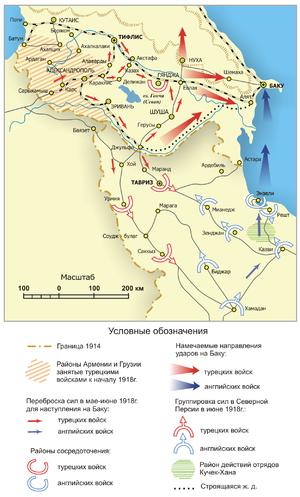



![Murad of Sebastia led his volunteers and died at the Battle of Baku[8]](/w/images/thumb/f/fb/Armenian_Resistance_-Mourat_-_Defense_of_Erzinjan_1916.png/73px-Armenian_Resistance_-Mourat_-_Defense_of_Erzinjan_1916.png)

